Home > Download > Learning resources > Web page production

Usability design is the most important and difficult task in web design. Based on years of experience in the industry, the author of this book analyzes user psychology and puts forward many unique views on user usage patterns, design for scanning, navigation design, homepage layout, usability testing, etc., and provides a large number of simple and easy-to-use tools. line of usability design recommendations. This book is short and concise, and the language is relaxed and humorous. It is interspersed with a large number of colorful screenshots, interesting cartoon illustrations, and charts containing a large amount of information, making boring design principles approachable. This book is suitable for technical personnel engaged in Web design and Web development, especially for website/webpage designers who are worried about how to retain visitors. <br /> Some websites look very refreshing; <br /> Some websites look cluttered; <br /> Some websites allow you to find information easily; <br /> Some websites make you feel like you are in a maze... <br /> Why is there such a huge contrast in website usability? <br /> What kind of psychology do users have when visiting the website? <br /> What principles should be followed to design a website to attract visitors? <br /> This must-read classic for web designers around the world will give you the answer. <br /> This is a book about web design principles rather than web design techniques. The author of this book is a Web design expert with rich practical experience. He uses humorous language to reveal important but easily overlooked issues in web design. In just a few hours, you can find the crux of website design based on the design principles taught in the book, and make your website look brand new.
Web page production29861762018-01-11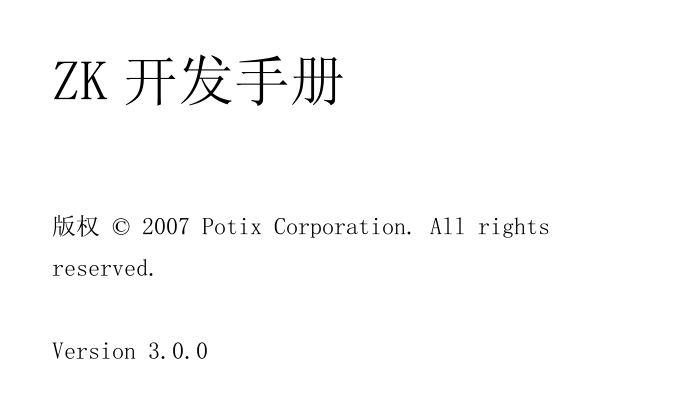
"ZK Chinese Development Manual" HD PDF version, ZK is a component-based, event-driven AJAX user interface framework, a behind-the-scene technology. With ZK, you can enrich your Web applications with XUL and XHTML, manipulating them to handle events caused by user activity, just like the desktop applications you've been using for years.
Web page production29864262018-01-11
HTML DOM defines standard methods for accessing and manipulating HTML documents. <br /> The HTML DOM presents an HTML document as a tree structure (node tree) with elements, attributes, and text. <br /> Start learning HTML DOM! <br /> HTML DOM example <br /> Learn from 100 examples! Using our editor you can edit an HTML document and click the TIY button to see the results.
Web page production29866472018-01-11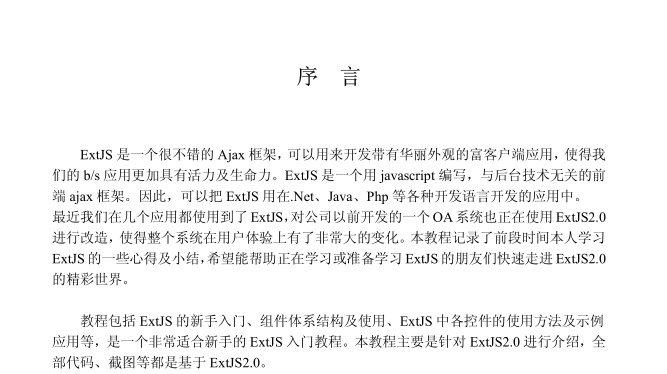
EXT is a relatively basic concise tutorial in PDF format, and the content is different from the previous concise tutorial. This tutorial is also aimed at entry-level students and is a preparation for learning EXT. The content mainly includes the basics and core introduction of the EXT framework, EXT usage panel, EXT windows and dialog boxes, layers and layouts, table controls, data storage, etc.
Web page production29862372018-01-11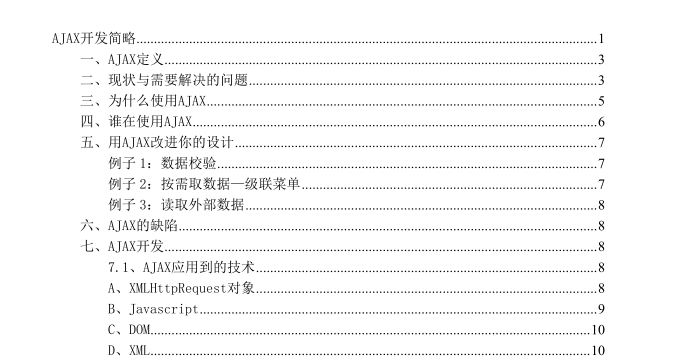
This book contains all the content of the sequel. It is a concise tutorial on AJAX development written by eamoi, an expert in AJAX programming. Mainly explained the following contents: <br /> 1. AJAX definition <br /> 2. Current situation and problems that need to be solved <br /> 3. Why use AJAX <br /> 4. Who is using AJAX <br /> 5. Use AJAX to improve your design <br /> Example 1: Data verification <br /> Example 2: Get data on demand—cascading menu <br /> Example 3: Reading external data <br /> 6. Defects of AJAX <br /> 7. AJAX development <br /> 7.1. Technologies applied to AJAX <br /> A. XMLHttpRequest object <br /> B. Javascript <br /> C. DOM <br /> D. XML <br /> 7.2. AJAX development framework <br /> A. Initialize the object and issue an XMLHttpRequest request <br /> B. Specify response processing function <br /> C. Make an HTTP request <br /> D. Process the information returned by the server <br /> E. A preliminary development framework <br /> 7.3. Simple example <br /> A. Data verification <br /> B. Cascading menu <br /> 7.4. Document Object Model (DOM) <br /> 7.4.1. HTML document in the eyes of DOM: tree <br /> 7.4.2. Nodes of HTML document <br /> 7.4.3. Use DOM to operate HTML documents.. <br /> 7.5. Process XML documents. <br /> 7.5.1. Processing the returned XML <br /> 7.5.2. Choose the appropriate XML generation method <br /> 7.5.3. How to weigh between using XML or normal text
Web page production29861592018-01-11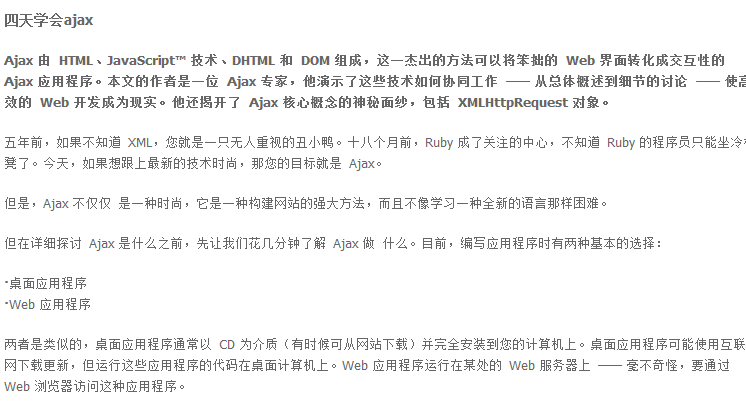
The author of this tutorial, an Ajax programming expert, uses this book to demonstrate how HTML, JavaScript™ technology, DHTML, and the DOM work together - from a general overview to a detailed discussion - to make efficient Web development becomes a reality. He also demystifies core Ajax concepts, including the XMLHttpRequest object.
Web page production29861902018-01-11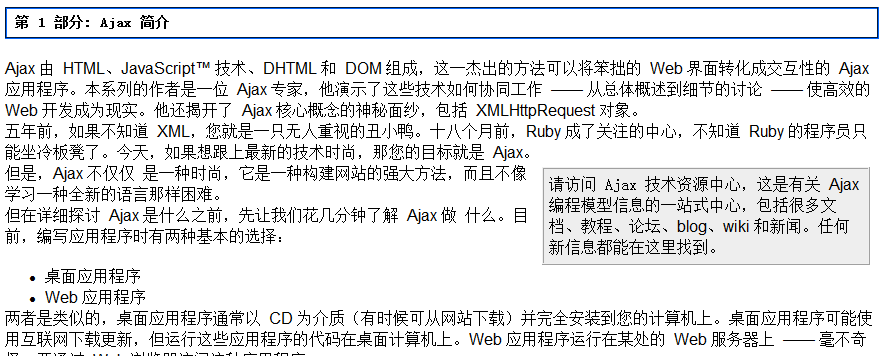
Part 1: Introduction to Ajax<br /> Consisting of HTML, JavaScript™ technology, DHTML, and the DOM, Ajax is a brilliant way to transform clumsy Web interfaces into interactive Ajax applications. The author of this series, an Ajax expert, demonstrates how these technologies work together—from a general overview to a detailed discussion—to make efficient Web development a reality. He also demystifies core Ajax concepts, including the XMLHttpRequest object. <br /> Five years ago, if you didn't know XML, you were an ugly duckling that no one took seriously. Eighteen months ago, Ruby became the center of attention, and programmers who didn't know Ruby had to sit on the bench. Today, if you want to keep up with the latest technology fads, your destination is Ajax. <br /> Visit the Ajax Technical Resource Center, your one-stop center for information about the Ajax programming model, including documentation, tutorials, forums, blogs, wikis, and news. Any new information can be found here. <br /> However, Ajax is more than just a fad; it's a powerful way to build websites that isn't as difficult as learning a whole new language. <br /> <br /> <br />
Web page production29863462018-01-11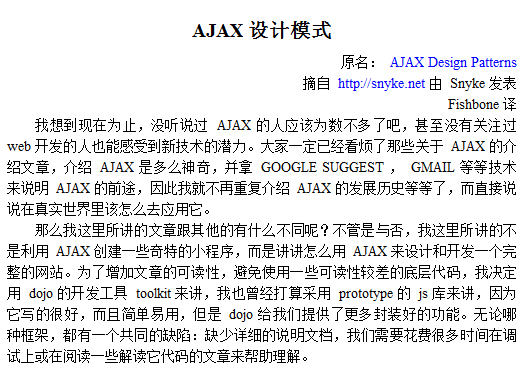
This booklet is not an authoritative book from an official organization, but it is a practical tutorial for beginners. Putting aside the official mixed language, here is a colloquial introduction to how to use AJAX to design and develop a highly interactive website. The author of this book uses Dojo's toolkit to implement Ajax applications, and does not use too much jQuery and prototype, because he thinks they are really good and easy to use, but Dojo provides us with more encapsulated functions, regardless of Each framework has a common flaw: the lack of detailed documentation, and we need to spend a lot of time debugging or reading some related articles to help understand.
Web page production29861542018-01-11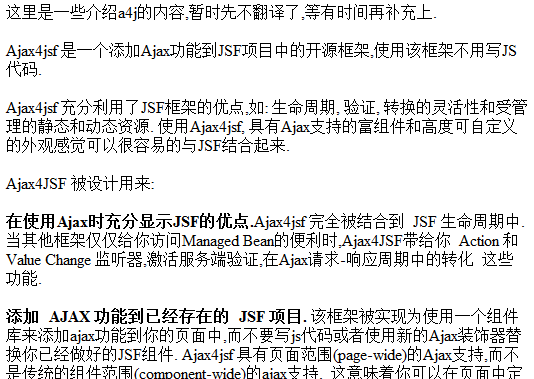
A4J-ajax4jsf, this book introduces some methods, functions, etc. Friends who study and research in this area can refer to it.
Web page production29860752018-01-11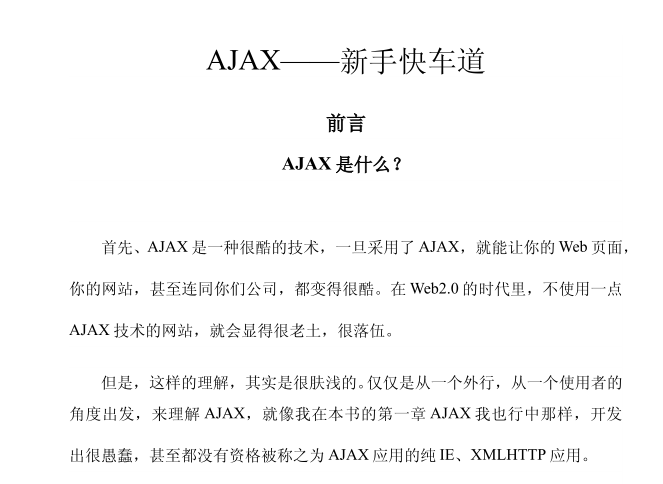
I feel a little guilty thinking about writing an AJAX book. What exactly is AJAX? I have to Google it first. So I discovered the article "a New Approach to Web Applications" that prompted the birth of AJAX. In this article, AJAX is a relatively inexplicable abbreviation: Asynchronous JavaScript XML. What is asynchronous JavaScript plus XML? After a preliminary browse, I believe that the reason why the name AJAX is so popular is entirely because of the world-famous Dutch team ②. The great thing about Jesse James Garrett's contribution is that he tried every means to come up with such an abbreviation, making some old technologies that everyone has been using for a long time become popular, popular, and fresh again. <br /> AJAX is a cool technology. Once you adopt AJAX, you can make your Web page beautiful. So, this book is a very good book for those who want to learn AJAX. It has a unique analysis of AJAX concepts, codes, etc.
Web page production29863322018-01-11
This book is a reference book for project development based on AJaX. It is suitable for web developers, enthusiasts who want to understand the application of AjaX technology, and junior and intermediate developers who have some experience in using Ajax. <br /> This book summarizes the typical applications of Ajax technology and basically covers the typical scenarios of AjaX technology application. There are a total of 45 examples in the book, divided into 9 chapters: dynamically loading data, improving user experience, e-commerce applications, server-side computing, web applications, automatic and scheduled services, server management, accessing third-party services and comprehensive projects. This book selects typical examples and explains in detail. By reading this book, readers can quickly master AjaX technology and apply it to actual projects.
Web page production29863272018-01-11
<pre class="pre_description">《正则指引》是2012年电子工业出版社出版的一本图书,作者余晟,ISBN9787121165511。基本信息作者:余晟 出版社:电子工业出版社 ISBN:9787121165511 出版日期:2012 年5月 开本:16开 页码:336</pre>
Web page production29910642018-01-10
<div style="margin:0px;padding:0px;color:#454545;font-family:"font-size:16px;background-color:#FFFFFF;"> Framework introduction: DWR (Direct Web Remoting) </div> <div style="margin:0px;padding:0px;color:#454545;font-family:"font-size:16px;background-color:#FFFFFF;"> It is a remote server-side Ajax open source framework used to improve the interaction between web pages and Java classes. It can help developers develop websites that include AJAX technology. It allows code in the browser to use JAVA functions running on the WEB server as if it were inside the browser. </div> <div style="margin:0px;padding:0px;color:#454545;font-family:"font-size:16px;background-color:#FFFFFF;"> <br /> </div> <div style="margin:0px;padding:0px;color:#454545;font-family:"font-size:16px;background-color:#FFFFFF;"> Basic functions implemented by this Demo: </div> <div style="margin:0px;padding:0px;color:#454545;font-family:"font-size:16px;background-color:#FFFFFF;"> Click the button on the jsp interface, call the server-side java code through DWR, and print out the value in the jsp input box on the console </div>
Web page production29907912018-01-10
<p class="reader-word-layer reader-word-s1-10"> Decrypt the powerful functions of EditPlus - you will get twice the result with half the effort by using regular expressions. Friends who like to use editplus can download it and take a look. <br /> Regular expression application example directory <br /> 【1】 Regular expression application - replace specified content to the end of the line <br /> 【2】 Regular expression application - number replacement <br /> 【3】 Regular expression application—delete the specified characters at the end of each line <br /> 【4】 Regular expression application - replace multiple lines with half-angle brackets <br /> 【5】 Regular expression application-delete blank lines <br /> 【6】Software Tips - Precautions for Keylogging <br /> 【7】Software Tips - Convenient way to close document tags <br /> 【8】Software Tips - How to remove the suffix prompt when saving text files in EditPlus? <br /> 【9】Software Tips - Solution to the prompt that the grammar file cannot be found <br /> 【10】Software Tips - Set editplus to support other texts, such as Korean <br /> 【11】Software skills - FTP upload settings <br /> 【12】Software Tips—How to disable the backup file function? <br /> 【13】Software skills - add grammar files, auto-complete files, and editing library files <br /> 【14】Tool integration - compiler integration examples (Java, Borland C, Visual C, Inno Setup, nsis, C#) <br /> 【15】Tool integration-let Editplus debug PHP programs <br /> 【16】Tool Integration - Creating PHP Debugging Environment (2) <br /> 【17】Integrate EDITPLUS in WINPE <br /> 【18】Support files with UTF-8 mark/without UTF-8 mark </p>
Web page production29907342018-01-10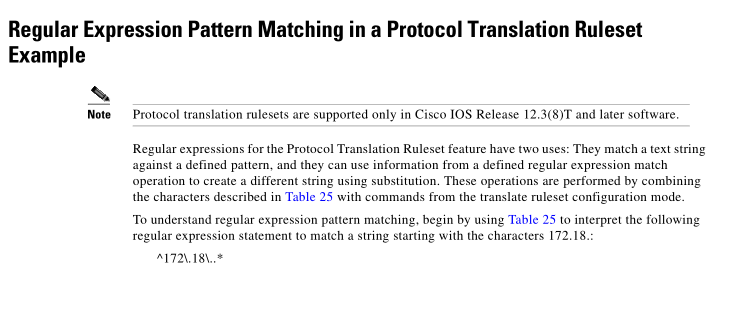
<p> Regular expression, also known as regular expression, regular expression, regular expression, regular expression, regular expression (English: Regular Expression, often abbreviated as regex, regexp or RE in code). </p> <p> Regular expressions use a single string to describe and match a series of strings that match a certain syntax rule. In many text editors, regular expressions are often used to retrieve and replace text that matches a certain pattern. </p> <p> 1. Character class </p> <p> 1. Character class: can match any character it contains </p> <p> eg: /[abc]/ matches any one of the letters "a", "b", and "c" </p> <p> 2. Negative character class: Define the negative character class through the "^" character, which matches all characters not contained in square brackets. When defining a negative character class, put a "^" symbol as the first character inside the left bracket. </p> <p> eg:/[^abc]/ matches all characters except "a", "b", and "c". </p> <p> 3. \s: matches spaces, tabs and other Unicode whitespace characters; </p> <p> . : Any character except newlines and other Unicode line terminators. </p>
Web page production29908672018-01-10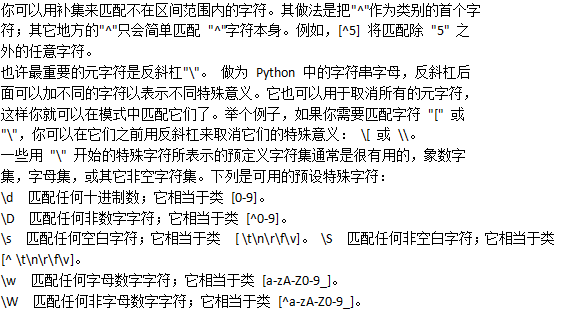
<p style="font-family:Verdana, Geneva, Arial, Helvetica, sans-serif;font-size:13px;background-color:#FFFFFF;"> <span style="font-family:"">The function prototype of re.match is: re.match(pattern, string, flags)</span> </p> <p style="font-family:Verdana, Geneva, Arial, Helvetica, sans-serif;font-size:13px;background-color:#FFFFFF;"> <span style="font-family:"">The first parameter is a regular expression, here it is "(\w )\s". If the match is successful, a Match is returned, otherwise a None is returned; </span> </p> <p style="font-family:Verdana, Geneva, Arial, Helvetica, sans-serif;font-size:13px;background-color:#FFFFFF;"> <span style="font-family:"">The second parameter represents the string to be matched;</span> </p> <p style="font-family:Verdana, Geneva, Arial, Helvetica, sans-serif;font-size:13px;background-color:#FFFFFF;"> <span style="font-family:"">The third parameter is the Peugeot bit, which is used to control the matching method of regular expressions, such as: whether to be case-sensitive, multi-line matching, etc. </span> </p>
Web page production29911092018-01-10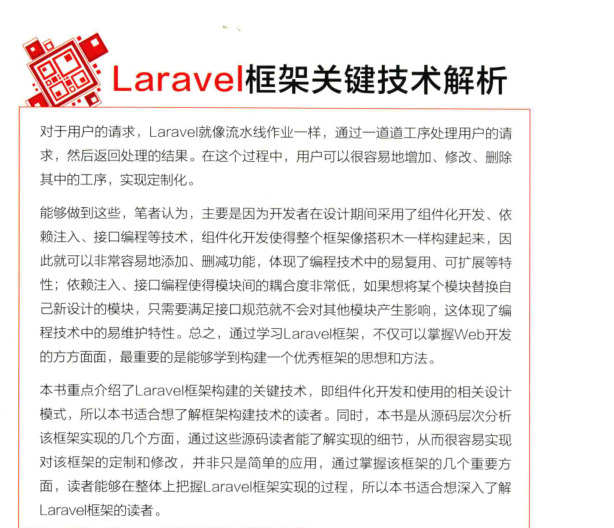
The essence of the aravel framework is also made up of a bunch of excellent components. To understand the laravel framework, you need to understand the various components used in the laravel framework. <br /> Among the various component libraries in php, the two most important ones are Packagist PEAR<br /> Among them, Packagist cooperates with Composer. Composer can be used to install components in packagist and complete automatic loading. <br /> After using composer to download the components locally, two files, composer.json and composer.lock, will be generated. The composer.lock file will list all the PHP components of the project and the specific version numbers of the components. This locks the version and allows the project to only Ability to use specific versions of PHP components. The advantage of this is that composer will download the specific version listed in this file, regardless of the latest version available in Packagist. You should put the composer.lock file into version control so that team members use the same PHP version as you. If local development and the server use the same PHP component version, bugs caused by different component versions can be minimized. <br /> <br /> Composer's automatic loading is actually a file named autoload.php, which is saved in the vendor directory. When Composer downloads each PHP component, it will check the composer.json file of each component to determine how to load the component. After getting this information, Composer will create a kimono PSR standard autoloader locally for this component. This way we can instantiate any PHP component in the project. These components need to be loaded automatically. <br /> <br />
Web page production29911692018-01-10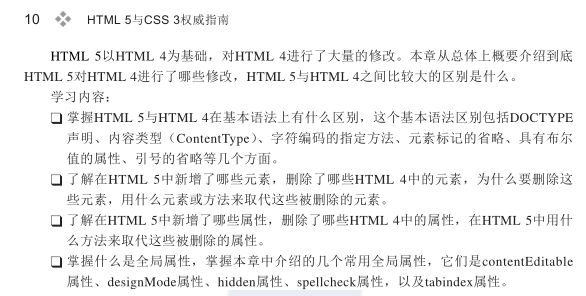
<p style="color:#454545;font-family:"font-size:16px;background-color:#FFFFFF;"> HTML5 is a powerful force after HTML4. It encapsulates many APIs. We no longer need to write several lines of javascript to implement a simple function, but a single tag can solve the problem. It has very powerful semantic tags. It makes the layout concise and easy to understand and easy to maintain. The most important thing is that its compatibility is very powerful. It seems to be born to solve the compatibility problem. Although the syntax is different, it is also compatible with HTML4 writing method. Isn’t it very powerful? <br /> 1. New structural elements<br /> 1) section<br /> Represents a content block in the page, such as a chapter, header, footer or other part of the page, which can replace the previous div<br /> 2) article<br /> Represents a piece of independent content on the page that is not related to the context, such as an article in a blog. <br /> 3) aside<br /> Represents auxiliary information related to the content of the article element in addition to the content of the article element. <br /> 4) header<br /> 5)footer<br /> 6)hgroup<br /> Used to combine the titles of an entire page or a content block within a page<br /> 7) figure<br /> Represents an independent piece of stream content, generally representing an independent unit in the main stream content of the document, using <br /> figcaptionAdds a title to the figure element<br /> 8)nav<br /> </p>
Web page production29910012018-01-10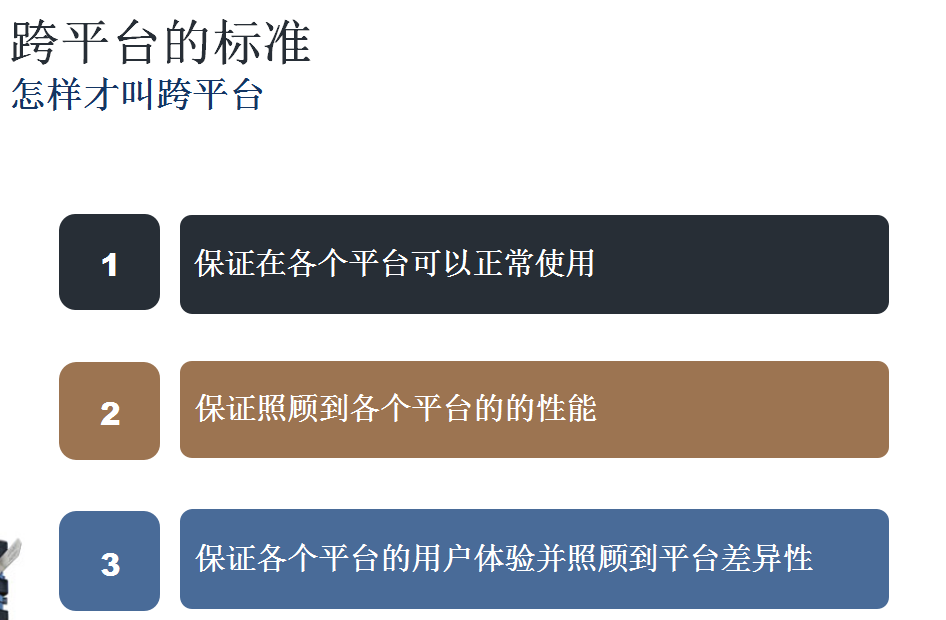
<p class="p" style="color:#454545;font-family:"font-size:16px;background-color:#FFFFFF;text-indent:21pt;"> <span style="font-family:宋体;line-height:21px;font-size:10.5pt;"><span>With the rapid development of </span>Chrome<span> and </span><span style="font-family:Calibri;">Safari</span><span>, and the decline of </span><span style="font-family:Calibri;">IE Flash</span><span>, </span><span style="font-family:Calibri;">HTML5</span><span> has come to an end and entered the next era - mobile Internet. The cross-platform advantages of </span><span style="font-family:Calibri;">HTML5</span><span> are further highlighted in the mobile Internet era. </span><span style="font-family:Calibri;">HTML5</span><span> is the only one that takes all </span><span style="font-family:Calibri;">PC</span><span>, </span><span style="font-family:Calibri;">Mac</span><span>, </span><span style="font-family:Calibri;">iPhone</span><span>、</span><span style="font-family:Calibri;">iPad</span><span>、</span><span style="font-family:Calibri;">Android</span><span>、</span><span style="font-family:Calibri;">Windows Phone</span><span> Cross-platform language for mainstream platforms such as ##. </span><span style="font-family:Calibri;">Java</span><span> and </span><span style="font-family:Calibri;">Flash</span><span> both dreamed of this position, but their dreams ended with </span><span style="font-family:Calibri;">iOS</span><span> . At this time, people began to study the development of cross-platform mobile applications based on </span><span style="font-family:Calibri;">HTML5</span><span>. Many people believed at the time that native applications were just a transition, just like the transition from the </span><span style="font-family:Calibri;">C/S</span><span> structure to the </span><span style="font-family:Calibri;">B/S</span><span> structure. And learning </span><span style="font-family:Calibri;">Objective-C</span><span> and </span><span style="font-family:Calibri;">Java</span><span> is very difficult. Since I know web development, why not try </span><span style="font-family:Calibri;">HTML5 </span><span>. </span></span><span style="font-family:宋体;line-height:21px;font-size:10.5pt;"></span> </p><p class="p" style="color:#454545;font-family:"font-size:16px;background-color:#FFFFFF;text-indent:21pt;"> <span style="font-family:宋体;line-height:21px;font-size:10.5pt;">W3C<span> At this time, the </span><span style="font-family:Calibri;">Device API</span><span> working group was established to extend </span><span style="font-family:Calibri;"> for </span><span>HTML5</span><span style="font-family:Calibri;"> Camera</span><span>, </span><span style="font-family:Calibri;">GPS</span><span> and other </span><span style="font-family:Calibri;">#API</span><span> that are unique to mobile phones. However, the trouble is that the early iterations of the mobile Internet were too Soon, the mobile phone</span><span style="font-family:Calibri;">OS</span><span> is constantly expanding the hardware</span><span style="font-family:Calibri;">API</span><span>, gyroscope, distance sensor, barometer</span></span><span style="font-family:宋体;line-height:21px;font-size:10.5pt;">. </span><span style="font-family:宋体;line-height:21px;font-size:10.5pt;"><span>Every year there are major version updates for mobile phones. As an organization where hundreds of member units make joint decisions, </span>W3C<span> has a very complicated process from proposing a standard draft to reaching a consensus, which cannot keep up with the rapid iteration in the early stages of the mobile Internet. </span></span><span style="font-family:宋体;line-height:21px;font-size:10.5pt;"></span> </p> <p class="p" style="color:#454545;font-family:"font-size:16px;background-color:#FFFFFF;text-indent:21pt;"> The emergence of <span style="font-family:宋体;line-height:21px;font-size:10.5pt;">PhoneGap<span> has opened a window for developers. Many people expect </span><span style="font-family:Calibri;">PhoneGap</span><span> to continue to expand</span><span style="font-family:Calibri;">API</span><span> to supplement the shortcomings of the browser. </span><span style="font-family:Calibri;">Adobe</span><span> Seeing </span><span style="font-family:Calibri;">PhoneGap</span><span> seems to have seen the hope of revitalizing the status quo, but in </span><span style="font-family:Calibri;">Adobe</span> <span>After acquiring </span><span style="font-family:Calibri;">PhoneGap</span><span>, I found that this thing is not commercially viable enough, and open source makes </span><span style="font-family:Calibri;">Adobe</span><span> unable to be like </span><span style="font-family:Calibri;">Flash</span><span> obtained commercial interests in this way, so he donated </span><span style="font-family:Calibri;">PhoneGap</span><span> to </span><span style="font-family:Calibri;">Apache</span><span> and changed its name to </span><span style="font-family:Calibri;">Cordova</span><span>. </span></span><span style="font-family:宋体;line-height:21px;font-size:10.5pt;"></span> </p><p class="p" style="color:#454545;font-family:"font-size:16px;background-color:#FFFFFF;text-indent:21pt;"> <span style="font-family:宋体;line-height:21px;font-size:10.5pt;"><span>Due to various reasons, the positioning of </span>Cordova<span> ultimately did not become a browser enhancement, but moved towards hybrid development. Based on the background at the time, they believed that native was irreplaceable, and the hybrid mode of "native</span><span style="font-family:Calibri;"> HTML5</span><span>" made more sense. So now the usage model of </span><span style="font-family:Calibri;">Cordova</span><span> is that "native engineers </span><span style="font-family:Calibri;"> HTML5</span><span> engineers" work together to complete </span><span style="font-family:Calibri;">App</span> <span>. </span></span><span style="font-family:宋体;line-height:21px;font-size:10.5pt;"></span> </p> <p class="p" style="color:#454545;font-family:"font-size:16px;background-color:#FFFFFF;text-indent:21pt;"> <span style="font-family:宋体;line-height:21px;font-size:10.5pt;"><span>At this time</span>Facebook<span> joined </span><span style="font-family:Calibri;">W3C</span><span> and took the lead in establishing the </span><span style="font-family:Calibri;">Mobile Web</span><span> working group . </span><span style="font-family:Calibri;">Facebook</span><span> is in the </span><span style="font-family:Calibri;">Web</span><span> circle, and does not have itself on the mobile phone</span><span style="font-family:Calibri;">OS</span><span> territory, he doesn’t like the native app ecosystem controlled by Apple and </span><span style="font-family:Calibri;">Google</span><span>. </span><span style="font-family:Calibri;">Mobile Web</span><span>The important goal of this working group is to make web applications developed by </span><span style="font-family:Calibri;">HTML5</span><span> achieve the experience of native applications. However, things backfired. It didn't matter if it didn't work hard. The result was that it failed despite trying hard. </span><span style="font-family:Calibri;">2012</span><span>, the news that </span><span style="font-family:Calibri;">Facebook</span><span> gave up on </span><span style="font-family:Calibri;">HTML5</span><span> flooded the world </span><span style="font-family:Calibri;">IT</span><span>Media, </span><span style="font-family:Calibri;">HTML5</span><span> were instantly thrown into limbo. </span></span><span style="font-family:宋体;line-height:21px;font-size:10.5pt;"></span> </p><p class="p" style="color:#454545;font-family:"font-size:16px;background-color:#FFFFFF;text-indent:21pt;"> <span style="font-family:宋体;line-height:21px;font-size:10.5pt;">Facebook<span>Why gave up </span><span style="font-family:Calibri;">HTML5?</span><span>The core is that based on </span><span style="font-family:Calibri;">HTML5</span><span>, we really couldn’t make good mobile</span><span style="font-family:Calibri;">App</span><span>. Compare </span><span style="font-family:Calibri;">Twritter</span><span> and other competitors’ native </span><span style="font-family:Calibri;">App</span><span>, </span><span style="font-family:Calibri;">Facebook</span><span>’s </span> <span style="font-family:Calibri;">HTML5</span><span> version really cannot satisfy users. For example, regarding the </span><span style="font-family:Calibri;">Push</span><span> function, there is still a huge gap between the </span><span style="font-family:Calibri;">HTML5</span><span> push experience and the native push experience, let alone </span><span style="font-family:Calibri;">HTML5</span><span> There are many problems such as white screen when switching the application page, pull-down refresh</span><span style="font-family:Calibri;">/</span><span> The side sliding menu is not smooth, etc. Watching native engineers easily implement functions such as shake, QR code, voice input, and sharing to Moments made </span><span style="font-family:Calibri;">HTML5</span><span> engineers feel like they were on the wrong team. </span></span><span style="font-family:宋体;line-height:21px;font-size:10.5pt;"></span> </p> <p class="p" style="color:#454545;font-family:"font-size:16px;background-color:#FFFFFF;text-indent:21pt;"> <span style="font-family:宋体;line-height:21px;font-size:10.5pt;"><span>Even if </span>Facebook<span> doesn’t like to be controlled, we can’t risk being abandoned by users. And </span><span style="font-family:Calibri;">Facebook</span><span> has not mastered the key point - the mobile browser core. If browsers don't keep up, a bunch of draft standards will be in vain. </span></span><span style="font-family:宋体;line-height:21px;font-size:10.5pt;"></span> </p><p class="p" style="color:#454545;font-family:"font-size:16px;background-color:#FFFFFF;text-indent:21pt;"> <span style="font-family:宋体;line-height:21px;font-size:10.5pt;"><span>What is the performance of the browser on the mobile phone?</span>?<span>Look first</span><span style="font-family:Calibri;">Google</span><span>,</span><span style="font-family:Calibri;">Chrome</span> <span>Although the performance is high, the browser on </span><span style="font-family:Calibri;">Android</span><span> is not </span><span style="font-family:Calibri;">Chrome</span><span>, but </span><span style="font-family:Calibri;">WebKit </span><span>A crappy modification</span><span style="font-family:Calibri;">Android</span><span>browser</span><span style="font-family:Calibri;">;</span><span>Look at Apple again,</span><span style="font-family:Calibri;"> Other browser engines are not allowed to be listed on the </span><span>App Store</span><span style="font-family:Calibri;"> on iOS</span><span>, and other applications using the </span><span style="font-family:Calibri;">Safari</span><span> engine are not allowed Unable to call Apple's own </span><span style="font-family:Calibri;">JavaScript</span><span>acceleration engine</span><span style="font-family:Calibri;">Nitro</span><span>. The result is that Apple and </span><span style="font-family:Calibri;">Google</span><span> not only do not actively implement </span><span style="font-family:Calibri;">HTML5</span><span> on mobile</span><span style="font-family:Calibri;">App</span><span>The required specifications instead impose various restrictions on </span><span style="font-family:Calibri;">HTML5</span><span>. </span></span><span style="font-family:宋体;line-height:21px;font-size:10.5pt;"></span> </p> <p class="p" style="color:#454545;font-family:"font-size:16px;background-color:#FFFFFF;text-indent:21pt;"> <span style="font-family:宋体;line-height:21px;font-size:10.5pt;"><span>Whether it was the lack of hardware capabilities at the time or the deliberate restrictions of mobile phone </span>OS<span> manufacturers, the result is: in the early days of the mobile Internet, the world must be dominated by the native application ecosystem, </span><span style="font-family:Calibri;">iOS</span><span>and</span><span style="font-family:Calibri;">Android</span><span>First of all, after their territory is stabilized, the industry will upgrade to the next stage. </span></span><span style="font-family:宋体;line-height:21px;font-size:10.5pt;"></span> </p><p class="p" style="color:#454545;font-family:"font-size:16px;background-color:#FFFFFF;text-indent:21pt;"> No matter <span style="font-family:宋体;line-height:21px;font-size:10.5pt;">Facebook<span> or </span><span style="font-family:Calibri;">PhoneGap</span><span>, you won’t be able to get a share of the mobile Internet in the early days, but if you persist, opportunities will often appear. </span></span><span style="font-family:宋体;line-height:21px;font-size:10.5pt;">And this year</span><span style="font-family:宋体;line-height:21px;font-size:10.5pt;">HTML5</span><span style="font-family:宋体;line-height:21px;font-size:10.5pt;"><span> games are on the forefront. How to seize the dividends of </span>H5<span> games in the spotlight? It depends on your own operating conditions. Nobita Game, H5 game interface. </span></span> </p>
Web page production29912282018-01-10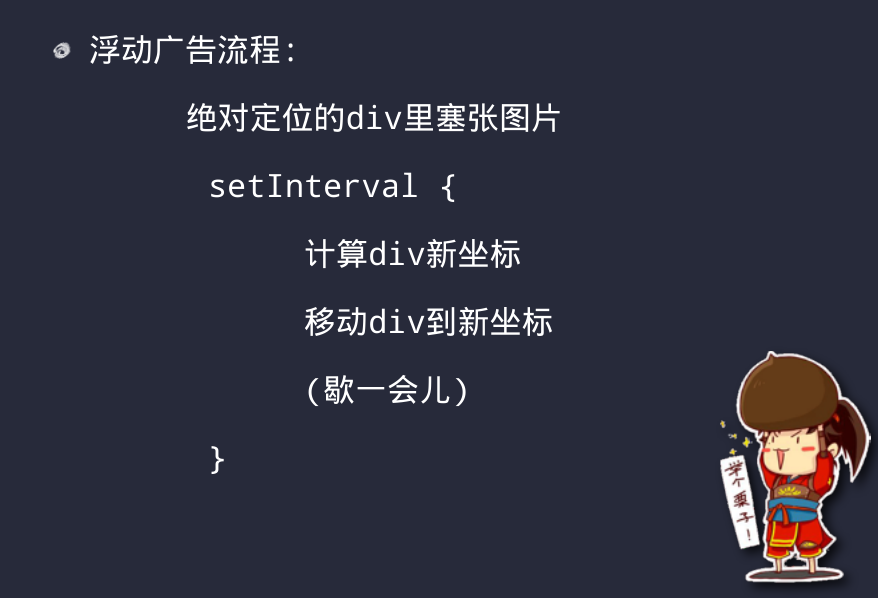
<span style="color:#454545;font-family:"font-size:16px;background-color:#FFFFFF;">Client</span><br /> <span style="color:#454545;font-family:"font-size:16px;background-color:#FFFFFF;">1. About the game engine</span><br /> <span style="color:#454545;font-family:"font-size:16px;background-color:#FFFFFF;">When I started preparing to make h5 games in March 2015, the first problem I encountered was engine selection. </span><br /> <span style="color:#454545;font-family:"font-size:16px;background-color:#FFFFFF;">There were three main 2d engines on the market at that time: egret, layabox and cocos2d-js. </span><br /> <span style="color:#454545;font-family:"font-size:16px;background-color:#FFFFFF;">On the one hand, it’s because I used cocos2d-x(c) to make mobile game clients for more than a year, so I naturally chose cocos2d-js. On the other hand, it was because there were not many successful projects with the other two engines on the market at that time. </span><br /> <span style="color:#454545;font-family:"font-size:16px;background-color:#FFFFFF;">Every time the cocos engine is updated, we will test it in our game as soon as possible. </span><br /> <span style="color:#454545;font-family:"font-size:16px;background-color:#FFFFFF;">If we find that the performance of the game on Android phones is significantly improved, we will upgrade it together with the engine version. Standing on the shoulders of giants, we can get twice the result with half the effort. </span><br /> <span style="color:#454545;font-family:"font-size:16px;background-color:#FFFFFF;">From v3.5 in March 2015, to v3.8 in September 2015, to v3.9 in November 2015, until the latest v3.12 in July 2016. We have updated the game engine 3 times in total! </span><br /> <span style="color:#454545;font-family:"font-size:16px;background-color:#FFFFFF;">PS: The OpenGl Test in js-tests was not able to see the running effect on the real Android device until v3.12, which made me burst into tears! </span><br /> <br /> <br /> <span style="color:#454545;font-family:"font-size:16px;background-color:#FFFFFF;">2. About data encryption and communication protocols</span><br /> <span style="color:#454545;font-family:"font-size:16px;background-color:#FFFFFF;">Because it is a strong network game, it can only be websocket. Because our original mobile game client and server used to be tcpsocket, the transmitted content was sha1-encrypted binary data in a custom format. </span><br /> <span style="color:#454545;font-family:"font-size:16px;background-color:#FFFFFF;">So the first difficulty of the project is how to use js to implement binary encoding and decoding of json strings, as well as sha1 encryption and decryption. </span><br /> <span style="color:#454545;font-family:"font-size:16px;background-color:#FFFFFF;">TODO: In fact, it is not necessary to encrypt, encode and decode every uplink and downlink. This will cause excessive pressure on the client and server CPUs. You only need to protect some important events (such as login, recharge, deduction of gold coins, etc.)! </span>
Web page production29910332018-01-10

